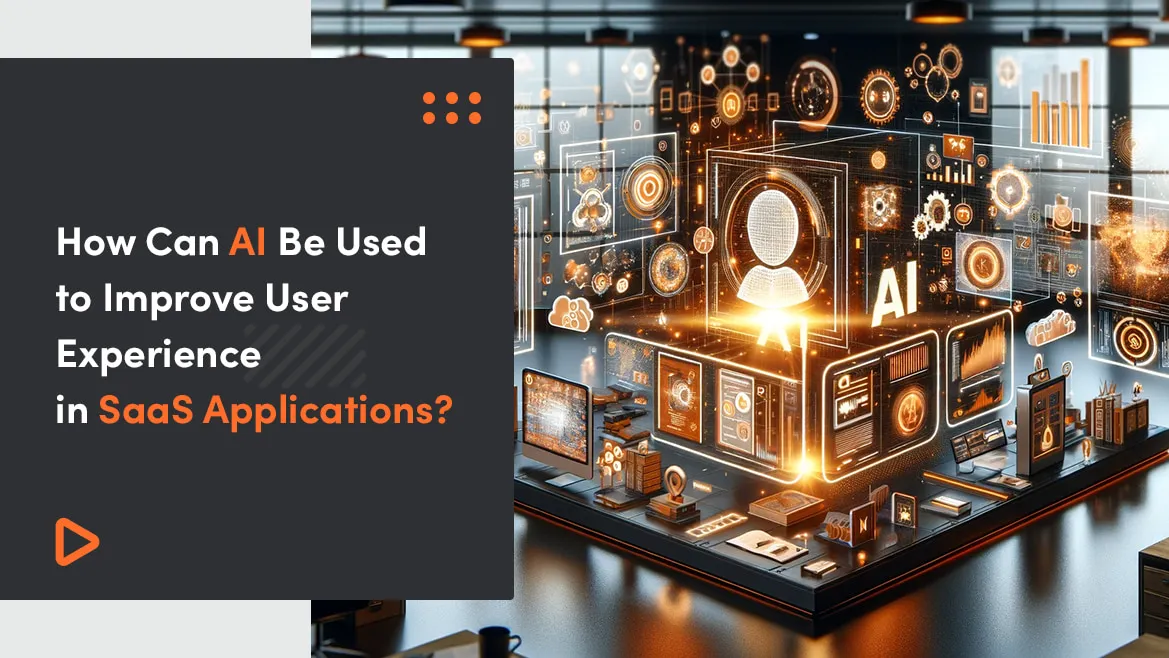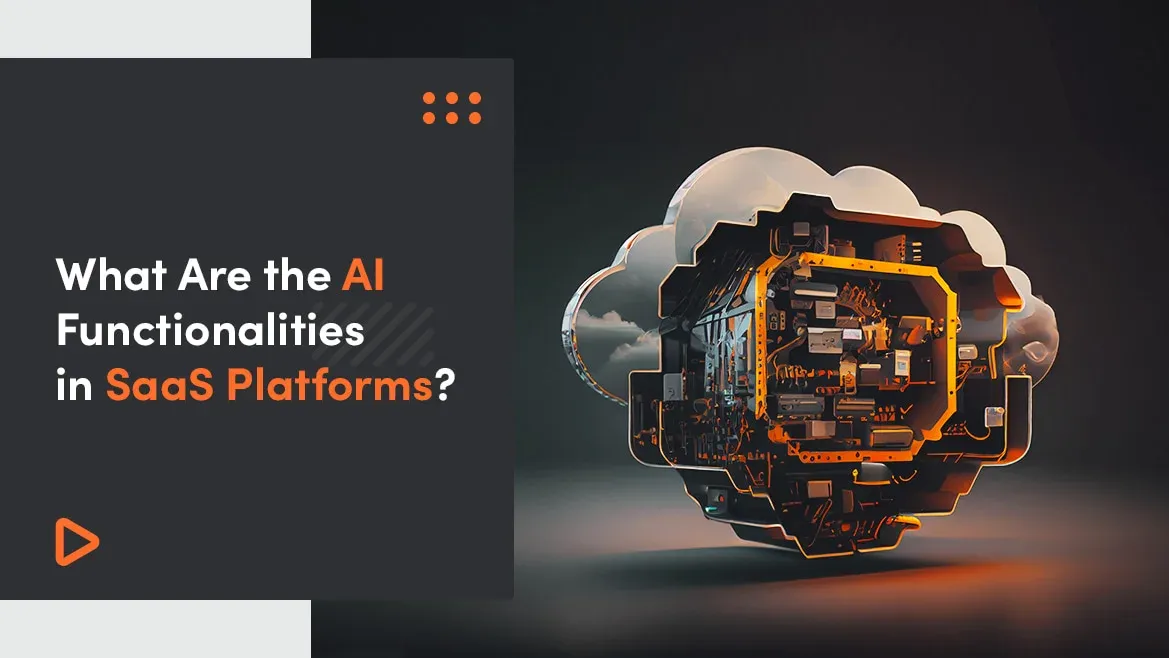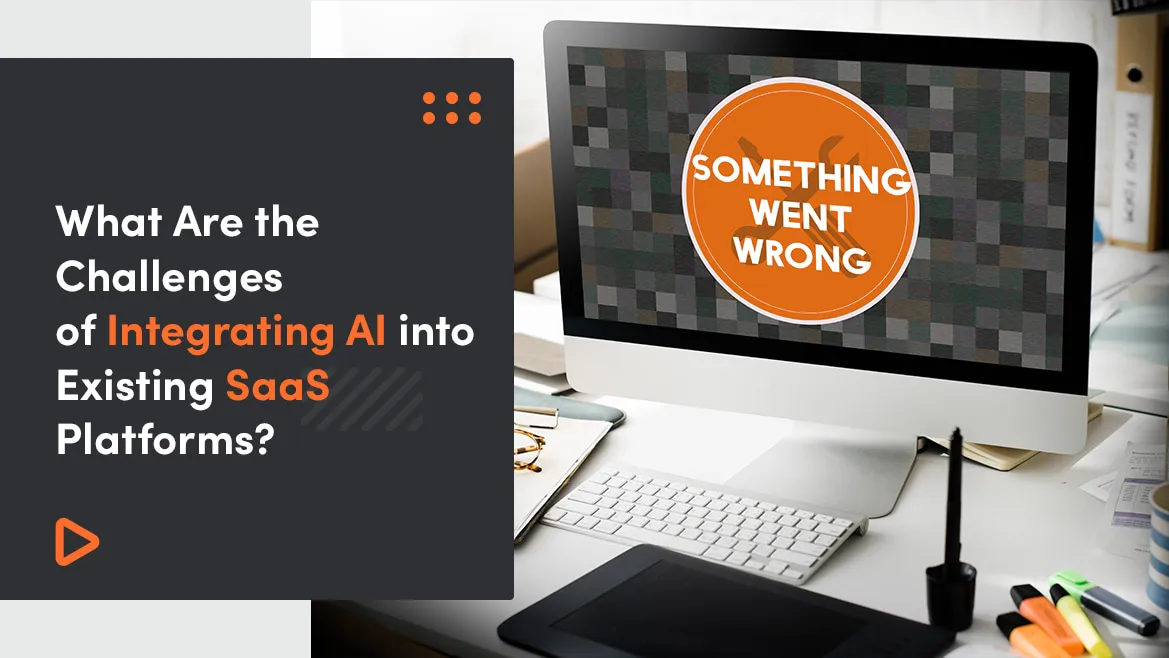Artificial Intelligence SaaS application is the most evolved technology in today's world, and there is a growing trend in the use of generative AI in SaaS-based application development.
According to research by Exploding Topics, MadX, the SaaS application market is expected to reach $571.9 billion by 2027. Similarly, according to Statista, the global AI market is expected to reach 126 billion U.S. dollars by 2025.
Both terms are not just buzzwords but are immensely transforming the software development and cloud computing landscape.
SaaS platform providers have started including artificial intelligence in their services as they become aware of its possible advantages. As per a Tech Jury poll, 35% of SaaS application-providing companies are now utilizing AI, and 42% want to do so soon.
AI and machine learning algorithms, which examine large data sets to provide forecasts and judgments, are two such techniques that many well-known SaaS companies heavily use. For example, sales representatives may discover possible prospects and provide tailored suggestions using Salesforce's Einstein AI, which employs machine learning algorithms.
One of the basic concepts of integrating AI in SaaS applications is based on the "heuristics principles". In 1990, Jakob Nielsen proposed ten guidelines to help develop user interfaces.
These are as follows:
- Visibility of system status;
- Match between the system and the real world;
- User control and freedom;
- Consistency and standards;
- Error prevention;
- Recognition rather than recall;
- Flexibility and efficiency of use;
- Aesthetic and minimalist design;
- Help users recognize, diagnose, and recover from errors;
- Help and documentation.
In this article, you will learn how AI can be used in SaaS application development to enhance user experience. You will also learn the following:
- How has AI changed the UX Paradigm?
- How to enhance user experience by using AI in SaaS application development?
- Reasons why it's worth using AI in SaaS application development
- Top SaaS application companies using AI in their products
- How new paradigm has changed the use of UX in SaaS application development company
How AI Has Changed the UX Paradigm
AI is introducing the third paradigm for user interfaces in computing history. Instead of relying solely on commands, users will now specify their goals and leave the focus of power in the hands of the computer, which means that users will tell it what they want, not how to accomplish it. "Intent-Based Outcome Specification" is the name of the newest paradigm.
Here's an overview of the previous Paradigm of the AI.
Paradigm 1: Batch Processing
Batch processing was the initial user interface paradigm. The output from the batch process would either not exist or be worthless, as it would not accurately represent all the information of the entire batch. It also lacks back-and-forth communication between the machine and UI. In this paradigm, the batch processing took days to provide the desired outcomes.
Paradigm 2: Command-Based Interaction Design
In the second paradigm, the user and the computer would alternate, executing commands one after the other. The fundamental method of interaction employed is command-based:
- Full-screen text-based terminals (typical of IBM mainframes)
- Command lines (like DOS and Unix)
- Graphical UIs (GUI: Macintosh, Windows, and all modern smartphone platforms)
- Remarkably potent and durable
Due to its immense strength, this paradigm has ruled the computing industry for almost 60 years.
Paradigm 3: Intent-Based Outcome Specification
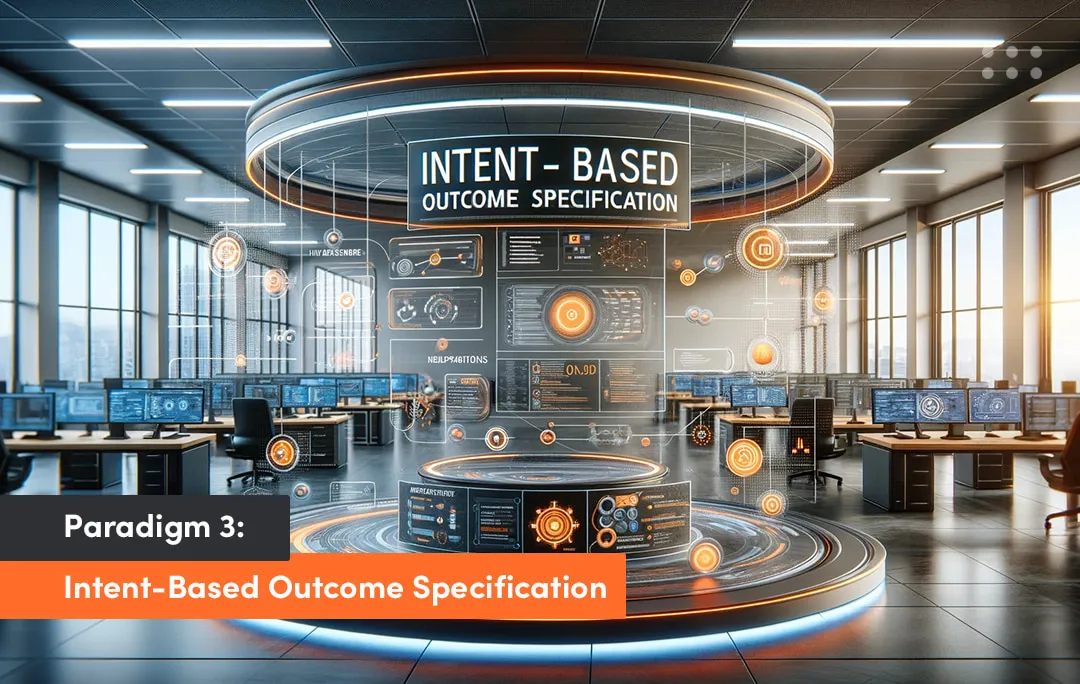
The generative AI tools we use nowadays, like ChatGPT, Bard, etc., their UIs have deep-rooted usability problems. The chat-based interaction style of ChatGPT requires users to write out their problems as prose text, which sometimes does not match with the algorithm used at the back of the ChatGPT interface, and as a result, the user doesn't get the desired outcome.
Based on these deep-rooted usability issues, an AI UI is needed to represent a different paradigm of the interaction between humans and computers. In the new command-based paradigm, the user issues commands to the computer one at a time. In this paradigm, the computer is fully obedient and does exactly what it's told. Still, usability systems often cause users to issue commands that do something different than the user wants.
Thanks to AI, now users do not tell the computer what to do. Instead, they tell the computer what outcome they need. The new paradigm is intent-based.
Why Is the New Paradigm of User Experience Important in SaaS Application?
88% of SaaS users will churn and never return after a bad user experience. On the other hand, a well-designed UX can boost conversion rates by up to 400%. These figures prove that user experience significantly influences a SaaS software development success or failure.
The new intent-based paradigm of UX is very important for SaaS companies. User expectations are no longer an optional add-on but a critical differentiator that influences customers' satisfaction, retention rates, and brand loyalty.
The new paradigm of UX and AI combination has opened new opportunities for user interaction, especially with automation, prediction, self-learning, human language processing, and decision-making capabilities. When UX combines with AI, the technology can predict the next execution steps like a human, which means that it makes the UX more human-like.
The new paradigm of UX will help SaaS companies to be powered with emotional intelligence. Further innovation will continue to improve intelligence capabilities, resulting in faster processing and decision-making with a more efficient and innovative data-handling capacity.
Try our developers.
Free for 2 weeks.
No risk. Just results. Get a feel for our process, speed, and quality — work with our developers for a trial sprint and see why global companies choose Selleo.
How to Improve the User Experience of SaaS Applications with Artificial Intelligence?
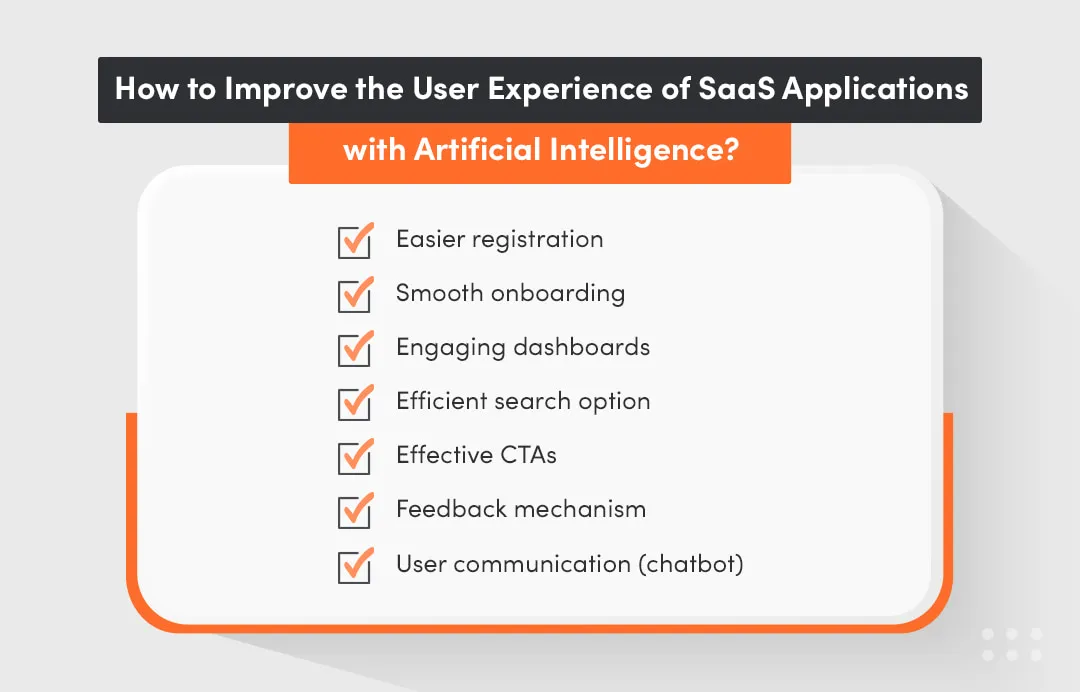
By leveraging AI-powered solutions, SaaS application development companies can unlock many opportunities to enhance customer satisfaction, engagement, and overall user experience. Here are some ways to improve the SaaS app user experience with AI.
Easier Registration
Artificial intelligence has completely changed several sectors, and registration procedures are one where its effects are becoming more noticeable. AI-powered solutions simplify processes, increase productivity, and produce results in various domains, including government services and business registrations. AI has helped SaaS startup companies to integrate a simple and easy registration process. The best example of this is Netflix, where a user can register with a simple email ID.
Smooth Onboarding
AI-powered onboarding experience eases the administrative workload in a SaaS application development company.
AI can tailor the onboarding experience to an individual's role, experiences, and preferences, which can build a sense of connection and belonging. Interactive AI platforms can provide personalized learning pathways considering an individual's skills and learning style. This ensures that every new hire receives the specific support they need to succeed in their new role.
Engaging Dashboards
The Dashboard is the first thing a user experiences when logging into SaaS apps. It is the first thing that defines the overall experience and hooks the users' attention. When the dashboard is simple, easy to understand, and easy to navigate, the users are satisfied. Integrating AI with SaaS applications to create a LIVE Dashboard that can integrate like a human with users always leads to a more significant ROI.
An ideal live dashboard may be represented by a character that the user can talk to. It needs to have its personality, communication style, and knowledge. It can also be trained to explain data literacy to users within the scope of the pilot data. For example, when users ask about a specific metric, the dashboard would use a suggested analogy to explain it, but beyond that, it could support the analogy with general information. A SaaS app development company should keep this feature on top of the list before developing SaaS apps.
Efficient Search Option
An efficient search option must be included in the SaaS application development. The search feature should be efficient enough to cover all the bases and answer all users' queries.
It should also have filtering options to provide the most relevant information to the user. As a result, an efficient search option finds the app's function that the user currently needs.
AI Chatbot search features are highly intuitive and provide a detailed search option. It can provide you with generic or specific both kinds of results based on the query you generate.
A SaaS app development company should do little research on what search functionality their users want in the SaaS applications.
Effective CTAs
Call-to-actions prompt specific users to take certain actions like purchasing, subscribing, or free trials. A CTA should be clear and prominent, especially for a SaaS application website. It is better to draft compelling words as CTA, such as "Start Trial", "Buy Now", "Subscribe Now", etc. The best use of AI is to A/B test CTAs for better user interactions. Based on the A/B testing results, enhance the design and wording of the CTAs.
Feedback Mechanism
AI has made it easy to collect large amounts of data from customer feedback and provide detailed analysis. Frequent analysis of customer feedback is important to reduce the churn rate. One of the biggest USPs of using AI in performance feedback is its ability to deliver prescriptive recommendations based on customer-provided suggestions.
Doing these would ensure ongoing design refinement with evolving user needs. The feedback mechanism also helps a SaaS application development company to innovate.
User Communication (chatbot)
AI-driven chatbots are highly impressive and well-driven for the overall user journey. AI Chatbots are much more efficient than normal chatbots. AI chatbots use algorithms to direct users in the right direction.
Ubersuggest, an SEO tool, has an inbuilt AI chatbot, which creates links to relevant content based on the entered keyword. This way, users get the relevant answers quickly and more effectively.
Moreover, while using AI chatbots, using MVP design is beneficial. It allows testing and refining Chatbot’s usefulness in a SaaS business model.
Reasons Why It’s Worth Implementing Good AI-driven UX
Using an AI-driven UX in a SaaS application development helps to attract and retain customers, fuels growth, and prevents churn rate. Plus, it leads to growth and saves costs. Here are some of the important reasons why implementing an AI-driven UX in SaaS app development is the best idea:
Retention and Customer Loyalty

A well-crafted, user-friendly, AI-driven SaaS application keeps its users loyal and satisfied. It also attracts potential customers and retains the old ones.
Moreover, a survey by Treasure Data confirms the power of good UX design for SaaS. It says that 74%of the time, customers’ buying experience influences them. On the other hand, 83% of business leaders risk losing profits because of poor UX. Integrating AI-driven personalization empowers businesses to create meaningful connections with users, ultimately leading to long-term success in the competitive e-commerce market.
Better Return on Investment
SaaS app UX plays a crucial part in driving user satisfaction, engagement, and the overall success of SaaS applications. It helps to lead the business to a more substantial return on investment.
Many businesses have gained high ROI by reducing monthly costs on their operational expenses due to AI integrations. Reduced operational cost ultimately increases ROI in the SaaS application development process.
Reduce Churn Rates
An AI-driven SaaS application UX design is a powerful way to reduce churn rates. AI integration helps collect users' feedback, provide in-depth analysis, reduce workload, and improve the overall user experience. AI also helps drive user adoption and validates their purchase decisions. As a result, it ensures they don't churn. Canva is the best example of a SaaS application that excels at creating a sense of empowerment.
Final thought: Competitive Advantage
A good SaaS app UX is about meeting customer expectations and should be built with a competitive advantage. The best AI-driven SaaS UX design considers customers' changing needs and adapts to them. This way, a business can position the software as an industry leader and become a success in this crowded SaaS landscape.
Popular SaaS Products Using AI
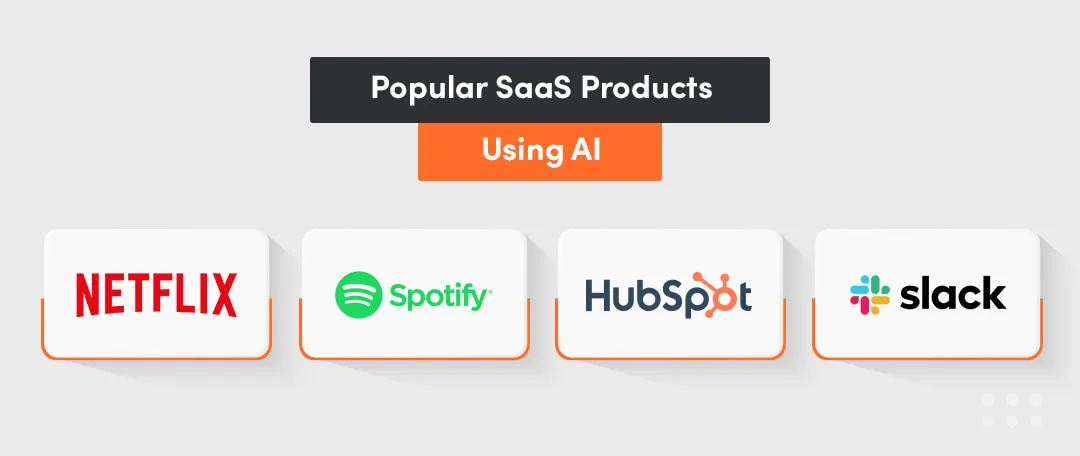
Here's a list of the top 4 SaaS applications using AI for a better and improved user experience. Here's how they have implemented AI in their applications to provide smooth onboarding and registration to their users, collect feedback, and provide chat support.
Netflix
Netflix harnesses the potential of generative AI to gain deep customer insights. This enables the platform to offer personalized recommendations and optimize content creation to improve user experience.
Onboarding process
Netflix utilized AI for the best user onboarding process with an uncluttered dashboard. All the CTAs are clear and allow users to register easily simply with email.
Landing page & navigational UX Design
Netflix's website is very easy to navigate. On the main page, you can see saved series/films, new releases, current productions, trends, etc. These categories are very clearly listed, making it easy for the user to navigate thanks to an AI-powered UX design.
Personalized Recommendations
To identify patterns, Netflix employs collaborative filtering algorithms that analyze user preferences and compare them with similar profiles.
The recommendation system accounts for contextual information, such as the time of day, day of the week, and popular trends, to further enhance the relevance of suggested content.
Enhancing Content Discovery
By showcasing a curated content selection based on individual preferences, Netflix encourages users to explore new genres and discover hidden gems.
Empirical Evidence
Netflix's AI-powered content tagging system improved metadata accuracy by 20%, resulting in more accurate content recommendations.
In 2021, Netflix released over 440 original titles, showcasing its ability to leverage AI for informed content creation decisions.
Spotify
Spotify uses artificial intelligence in many ways to create an incredible user listening experience.
Spotify AI DJ
Spotify's AI DJ is an AI-powered disc jockey that chooses what to play for users based on their music tastes and listening behavior. The AI DJ curates tracks based on individual user data and then narrates its selections in a hyper-realistic voice created by generative AI.
It will switch up songs and vibes based on real-time users' feedback.
AI-Powered Recommendations
Spotify leans heavily on reinforcement learning, a machine learning model that uses signals to optimize toward a goal. There is no clear explanation of the algorithm for recommending the music to users, but it mostly worked based on most likes, playlists, and saved numbers.
Spotify doesn't create a music monopoly; users can find their favorite music, podcasts, and audiobooks based on their interests.
Podcast Voice Translation
In 2023, Spotify introduced a feature called "Podcast Voice Translation." It is an AI-powered feature that translates podcasts into many languages using the host's original voice. The tool uses OpenAI to match the AI-generated voice with the host's and adjust the tone. By using this feature, a podcast originally recorded in English can be listened to in Japanese, Portuguese, Thai, and many other languages. The feature is being piloted with popular podcasters like Lex Fridman and Bill Simmons.
Spotify Wrapped
It is also an AI-generated feature where users can access a yearly personalized summary of their listening patterns throughout the year. I highlight users' most frequently played artists, songs, albums, and podcasts and stats on total listening minutes and favorite genres. It also curates a list of the top 100 tracks from users' playlists from the last year.
HubSpot
HubSpot has also integrated AI in many functions to enhance the tool's performance. Here's how HubSpot has integrated AI and provide features like:
HubSpot ChatSpot.A
HubSpot launched HubSpot ChatSpot.AI for its users to perform daily operations easily. The HubSpot AI assistant requires instructions in natural language and it will act on it.
It is an OpenAI’s database (ChatGPT and Dall-E), HubSpot ChatSpot gives users every chance to be creative and precise. Following are some of the assistance provided by HubSpot ChatSpot.ai:
- Prompt Templates.
- Real-time Data Reports (Sales, Marketing, Team Performance).
- Content creation (images, social copies, landing pages, & more).
HubSpot AI Content Writer
HubSpot has integrated the ChatGPT feature to provide writing assistance to its users. There are several ways where HubSpot AI content writers can assist users, such as in blog generation with an EAT SEO perspective. It also helps write and draft content for emails, website landing pages, and social media posts.
Smart Editor
HubSpot also offers an intelligent editor accessible from any location through the / slash command or by selecting text. This feature helps users instruct HubSpot writing assistants to rewrite, summarize, or expand content and also if they need to alter the tone of the provided content.
HubSpot AI Email Assistant
HubSpot has an AI-powered email assistant that provides email content per the required tone and target audience. Along with the AI Email Assistant, HubSpot has a feature that generates the best "Subject Lines" for your emails.
AI Image Generator
HubSpot + DALL-E combines to provide its users with visual content assistance. By using this feature, users can generate visuals and graphics.
The feature generates captivating images for blogs, social media posts, and users' marketing efforts.
Slack
Slack has also rolled out AI-powered features to help its users easily and more efficiently find old chats and threads.
Channel Recaps
This AI-powered feature will automatically generate summaries of messages sent on a particular channel. It will help users avoid unrelated chatter and catch up on meaningful conversations.
AI Search Option
Another handy feature Slack offers is the ability to search for answers based on relevant messages, files, and channels within Slack. A user can ask questions about a particular topic, and Slack AI will then generate a summary of that topic while including a link to the relevant conversation.
Summary
The most successful startups are the ones that are not afraid to adopt new technologies like machine learning and artificial intelligence.
Integrating AI into SaaS products can provide users with personalized services and enhanced user experience. With AI-powered features, you can achieve a competitive edge over other products in the market and enjoy added benefits like reduced operational cost, improved efficiency, and innovation.
If a SaaS company wants to stay ahead of its competition and grow, it is time to grasp and harness the power of AI. AI can help develop SaaS applications that have improved and enhanced user interfaces.
